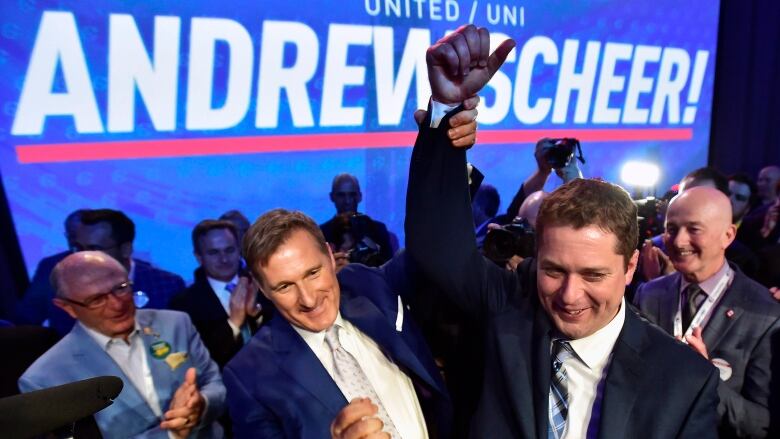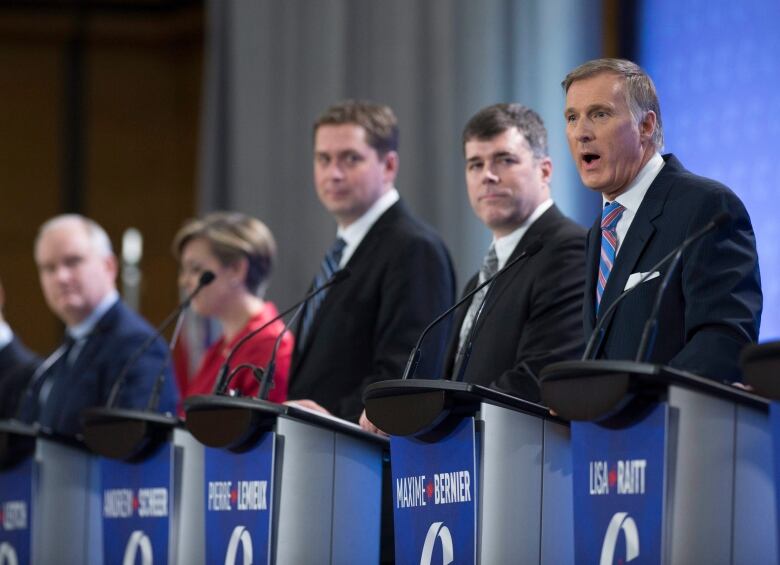What the 2017 Conservative leadership race told us about what it takes to win
To understand the next Conservative leadership race, look to the last one

At some point in the coming year, the Conservatives will choose a replacement for Andrew Scheer. Whenever it comes to a close,that race probably will look very different from the one that ended with Scheer's 13th ballot win over Maxime Bernier in 2017.
But that doesn't mean there aren't lessons to be learned from that contest.
A few factors will make the 2020 Conservative leadership race a very different beast. For starters, it's likely to be much shorter than the last one.The first contenders inthe 2017 contest threw their hats into the ring more than a year before the vote washeld. With Justin Trudeau's Liberals leading a minority government, the Conservatives don't have the luxury of a longer campaign this time.
Another factor: the Liberals will be asking for a third consecutive term in the next election. Though the Liberal Partyhas neverlosta third election when it haswona first and second, the prospects for the next leader of the Conservative Party look much better today than they did four years ago.
It's hard to defeat a first-term majority government. It should be much easier to defeat a two-term government headed up by a relatively unpopular leader. That suggests the calibre of candidates for the Conservative leadership in 2020 is likely to be much better than it was in 2017 because the person who wins will have a very good shot at becoming the next prime minister, rather than the next sacrificial lamb.
But the rules determining how the party chooses its leaders and the make-up of the party's membership were both decisive factors in the 2017 leadership contest. Those things won't be changing, even with a whole new group of candidates.
The metrics that matter
If you're looking for a predictive metric for this leadership race, don't look to polls. Unless they're sampling from a list of actual party members, polls can be (and often are) widely misleading in leadership races. The views of all Conservative voters don't necessarily align with those of party members. The views of all Canadians areeven less representative, and name recognition in the early going is an extremely significant factor.
In the absence of reliable polls of party members, the amount of money raised by each candidate and the number of endorsements they receivefrom fellow caucus members can be very instructive.
Bernier was the top fundraiser in the 2017 contest, but Scheer, Kellie Leitch, Erin O'Toole and Michael Chong also raiseda lot of money (so did Kevin O'Leary, who dropped out before it was all over). Bernier, Scheer and O'Toole had lots of endorsements in addition to good fundraising and they were the top three finishers on the first ballot.Chong and Leitch did not have lots of endorsements and finished further back.
Money and local backers are important in this kind of race. They can even be decisive because the party's rules force contestants to run national campaigns.
Location, location, location
Thoserules give each riding equal weight, which has a big impact ina party with a base that is disproportionately concentrated in Alberta and Saskatchewan.
Together, these two provinceshave 48 seats in the House of Commons, handed nearly 1.8 million votes to the Conservatives in October's election and represented about a quarter of all voting members in 2017's leadership race.
But Quebec where the Conservatives received less than 700,000 votes has 78 seats. That makes the province much more important in deciding the contest's winner than Alberta and Saskatchewan. It also puts a premium on the votes of individual members in Quebec; though their votes were worth less, there were nearly four times as many voting members from Alberta or Saskatchewan in 2017 than there were in Quebec.

There weren't any major regional candidates in 2017, leading to a patchwork of support for both Scheer and Bernier. While Scheer is from Western Canada, Bernier did quite well in Alberta and the urban centres in the region. And though Bernier was from Quebec, Scheerwon a big chunk of thatprovince (in part with the assistance of the dairy lobby, which was against Bernier's plan to dismantle supply management).
That might not be the case in this contest, however, particularly if there are notable regional figures who throw their hats into the ring people likePeter MacKay in Atlantic Canada, Grard Deltell in Quebec or Michelle Rempel Garner in Alberta. If that happens, the candidate who can hold a regional base while also attracting enough support from another big region of the country will have an advantage over a rival with more concentrated support even if that support iswhere most party members happen to live.
Old fault lines, they ain't what they used to be
A recurring topic of debate at Conservative party conventions has been whether to switch to a one-member-one-vote system or stay with the rules that giveeach riding equal weight, regardless of how many members are in it. The old Reform/Alliance wing has pushed for the former, while the Progressive Conservativewing has pushed for the latter. MacKay himself, who led the PCs into a merger with the Alliance in 2003, has argued in favour of keeping the system the way it is.
It's one of the few remaining examples of the old Reform/PC fault line running through the modern party. It's not clearhow deep those fault lines really go,however.
A few contestants represented the'Red Tory' wing in 2017 people like Chong, O'Toole and Lisa Raitt.

But who represented the old Reform wing? It's difficult to find an obvious standard-bearer. Scheer perhaps came the closest: his pitch to members wasacontinuation of the themes of the Stephen Harper years.
The old fault linenever materialized in the voting, however. When Raitt dropped off the ballot, her supporters split almost evenly between Bernier, O'Toole, Chong and Scheer. Chong's supporters went largely to O'Toole, suggesting significant overlap between thebackers of these two moderates. But when O'Toole dropped off after the penultimate round, his votes went disproportionately to Scheer over Bernier.
Hindsight in 2020
Scheer was able to win because he sat at the nexus of two party factions, as well as his own base of Harper Conservatives. Those factions were themoderates and the social conservatives (those who backed Brad Trost and Pierre Lemieux, whose supporters overwhelmingly went to Scheer). He was broadly acceptable to those who didn't want theradical departure from the Harper years that Bernier represented.
It all means the different factions of the party are malleable.
Being at the centre of the party membership's political spectrum is not necessarily the key to winning; the ranked ballot requires that a candidate have a strong enough base to make it to the later rounds and the 'centre' might not be the largest faction. If a candidate survives the round-by-round cull,however, they just need to be closer to the centre of the party than whoever else is still standing on thelast ballot.
On the face of it, winning this contest means following a relatively simple formula: havea regional base and the resourcesto expand beyond it to ensure a strong first ballot result, then growfrom that result by being thecandidate acceptable to the largest number of party members.
Pretty straightforward stuff. So, who fits the bill?













_(720p).jpg)


 OFFICIAL HD MUSIC VIDEO.jpg)
.jpg)



























































































